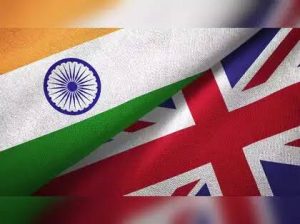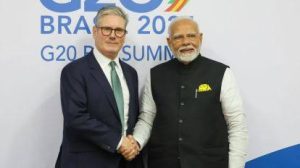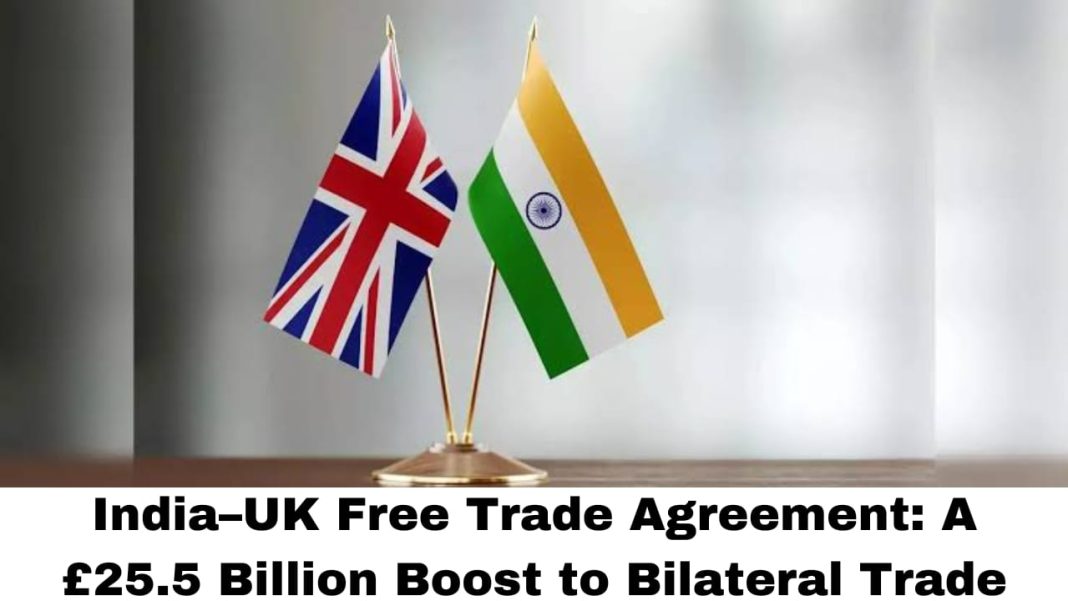Digital News Guru Business Desk:
India and UK Finalize Landmark Free Trade Agreement
In a significant development, India and the United Kingdom concluded negotiations on a comprehensive Free Trade Agreement (FTA) on May 6, 2025, marking a pivotal moment in their bilateral relations. This agreement, hailed as the most ambitious trade deal for both nations, aims to enhance economic cooperation and mutual growth.
Key Highlights of the Agreement
- Tariff Reductions and Trade Expansion
The FTA eliminates tariffs on approximately 90% of UK exports to India, including significant cuts for whisky, gin, cosmetics, and food products. This move is expected to double bilateral trade by 2030, potentially increasing it by £25.5 billion and boosting the UK economy by £4.8 billion by 2040.

- Automotive and Alcohol Sectors
India will provide import quotas for British combustion engine and electric vehicles, with phased tariff reductions based on engine capacity and vehicle prices. In the alcohol sector, India has agreed to remove minimum import price restrictions on spirits, enhancing the competitiveness of British Scotch whisky in the Indian market.
- Fashion and Luxury Goods
The agreement eliminates import duties for British fashion and beauty brands, potentially increasing bilateral trade by £25.5 billion and boosting the UK economy by £4.8 billion by 2040. This development is expected to invigorate interest from UK luxury labels in the rapidly growing Indian market.
- Professional Mobility and Social Security
The FTA allows only 1,800 additional visas annually for specific professionals, defying Indian ambitions to broaden work access. Additionally, Indian employees temporarily seconded to the UK are exempt from paying National Insurance Contributions (NICs) for up to three years, a move that will cost the UK government around £100 million.
- Carbon Border Adjustment Mechanism (CBAM)
The agreement includes provisions allowing India to retaliate should the UK enforce the CBAM, which imposes higher taxes on imports from countries lacking stringent climate policies. India has requested exemption from CBAM.
Implementation Timeline
While the agreement has been finalized, its implementation could take up to 15 months, with efforts underway to expedite the process. The legal scrubbing of the 26 chapters of the FTA will be conducted jointly by India and the UK.

Economic and Political Implications
For the UK:
The FTA is projected to boost the UK economy by £4.8 billion annually by 2040. It offers significant opportunities for UK businesses, particularly in the automotive, alcohol, fashion, and beauty sectors. However, the agreement has faced criticism over the NIC exemption for Indian workers and limited access for UK service sectors like finance and law.
For India:
India gains enhanced access to the UK market, especially for its textile and food products. The agreement also supports Indian designers and exporters, enabling clearer trade regulations and potentially expanding their presence in the UK. However, India’s request for broader work access was not fully met, with only 1,800 additional visas granted annually for specific professionals.
Conclusion
India and the United Kingdom have concluded negotiations on a bilateral free trade agreement, expected to be signed in approximately three months. Key aspects of the deal include:
- Automobile Imports: India will provide import quotas to the UK for combustion engine and electric vehicles, with tariffs to be reduced gradually based on engine capacity and vehicle prices.
- Carbon Border Adjustment Mechanism (CBAM): The agreement addresses India’s request to be exempt from the UK’s proposed CBAM, which imposes higher taxes on imports from countries with less stringent climate policies. India has reserved the right to retaliate if the CBAM is enacted.

- Alcohol Imports: India did not set a minimum import price for tariff cuts on alcohol, aiming to enhance the competitiveness of British Scotch whisky in the Indian market.
The India-UK Free Trade Agreement marks a significant milestone in bilateral relations, aiming to strengthen economic ties and provide mutual benefits to both nations. While it opens new avenues for trade and cooperation, the agreement also highlights the complexities and compromises inherent in international trade negotiations.
You May Also Read: Operation Sindoor: Rafale Jets and SCALP Missiles, Inside India’s 23-Minute Operation Sindoor








